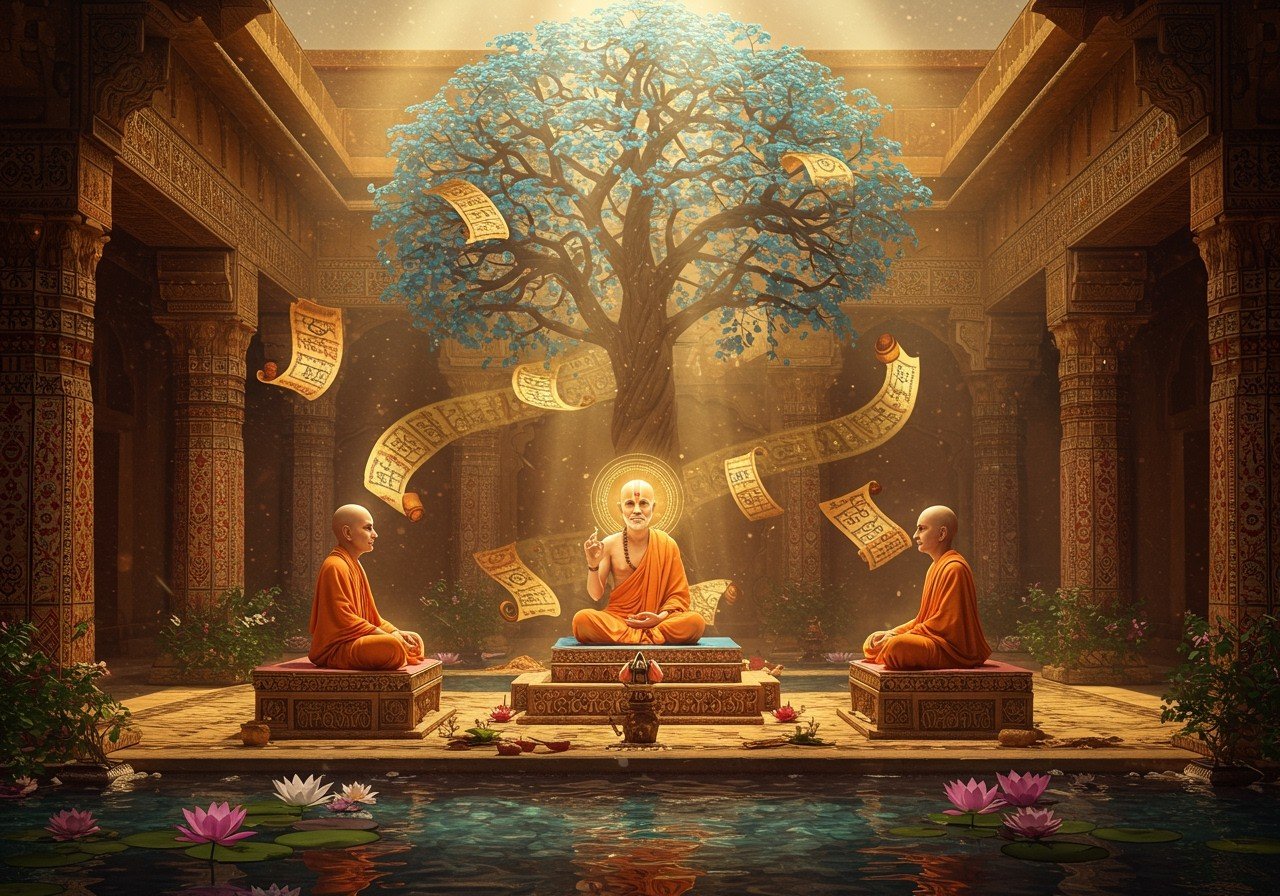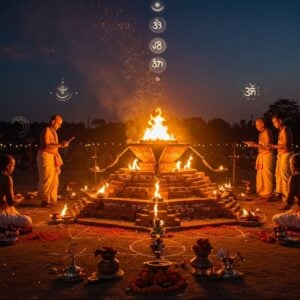Delving into Tattva-vada: Navadvipa’s Philosophical Heritage

Navadvipa, a revered spiritual hub in West Bengal, India, is renowned for its profound philosophical traditions, particularly Tattva-vada. This blog post explores Tattva-vada, a prominent philosophy within the Vedanta school of thought. We will examine the core tenets of Tattva-vada, compare it with other Vedanta schools, and delve into its influence on Navadvipa’s vibrant culture.
Core Principles of Tattva-vada
Tattva-vada, also known as Dvaita Vedanta, presents a dualistic perspective on reality. It distinguishes itself from Advaita Vedanta’s non-dualism by asserting two distinct realities: the supreme God (Vishnu) and individual souls (Jivas). Established by Madhvacharya, Tattva-vada outlines five fundamental distinctions:
- The distinction between God and the soul: This distinction emphasizes the inherent difference in nature and attributes between the supreme God and the individual souls.
- The distinction between God and matter: This highlights the separation between the divine creator and the material world.
- The distinction between the soul and matter: This distinction clarifies the difference between the conscious self and the physical body.
- The distinction among souls: Each individual soul is unique and separate from other souls. This uniqueness contributes to the diversity of experiences and perspectives within creation.
- The distinction among material objects: This acknowledges the variety and distinct properties of material objects in the world.
Tattva-vada venerates Vishnu as the supreme Godhead and underscores devotion and service to Him as the path to liberation. It emphasizes the importance of accurate knowledge (Tattva-jnana) to attain Moksha (liberation) and refutes the concept of Maya (illusion) as proposed in Advaita, asserting that the world is real and independent. Bhakti (devotion) and divine grace are crucial for transcending the cycle of birth and death.
Comparing Tattva-vada with Other Vedanta Schools
Tattva-vada offers a unique perspective within the Vedanta tradition. Unlike Advaita Vedanta, which advocates for non-dualism, Tattva-vada emphasizes dualism. Madhvacharya’s philosophy underscores the eternal separation between the divine and the soul. It diverges from Vishishtadvaita, which proposes qualified non-dualism, by asserting complete dualism. This school rejects Advaita’s concept of the world as illusory, maintaining that the world is real and independent.
Unlike Ramanuja’s Vishishtadvaita, which allows for a personal relationship with God while acknowledging a fundamental unity, Tattva-vada maintains clear distinctions. Bhakti, or devotion, is central to Tattva-vada for achieving liberation, aligning it with Bhakti traditions but with a unique understanding of divinity and the soul. Its influence extends to other movements, notably Gaudiya Vaishnavism, spearheaded by Chaitanya Mahaprabhu in Navadvipa. Exploring these differences enriches our understanding of the diversity within Vedanta and the philosophical landscape of Navadvipa.
For a deeper dive into Hindu philosophy, you can explore resources like “Hindu Philosophy Explained: A Beginner’s Guide” and “Connecting With Your Inner Self: A Hindu Philosophy Guide“. These resources offer further insights into the nuances of Hindu philosophical thought.
Navadvipa’s Philosophical Influence
Navadvipa flourishes as a center for philosophical discourse, with Tattva-vada playing a significant role. Renowned for its rich tradition, the city is home to numerous temples and institutions dedicated to Vedantic philosophies. Tattva-vada’s dualistic perspective influences the teachings of Gaudiya Vaishnavism, emphasizing a personal connection with the divine through Bhakti.
Navadvipa cultivates a dynamic cultural atmosphere, attracting scholars and devotees from around the globe. The annual Gaura Purnima festival celebrates the teachings of Chaitanya Mahaprabhu and Madhvacharya’s impact on devotional practices. The sacred Ganges River further enhances the city’s spiritual significance, symbolizing purity and enlightenment.
To delve deeper into the spiritual significance of pilgrimages, you can explore “Siddhatek Pilgrimage: Exploring the Ashtavinayak Trail.” This resource offers insights into the rich tradition of pilgrimages in India.
The philosophical heritage of Navadvipa continues to thrive through traditional rituals, literature, and educational institutions. For those seeking to immerse themselves in the diverse philosophies of India, Navadvipa offers an enriching experience that reflects a deep spiritual heritage and enduring influence.
How Poojn.in Supports Your Spiritual Journey
Poojn.in provides essential items for practicing Tattva-vada philosophy and performing related rituals. Our curated collection includes:
- Pure copper and brass puja items: Crafted according to traditional specifications, these items enhance the authenticity of your rituals and practices. Explore our Brass Laddu Gopal Murti
- Authentic Tulsi mala and prayer beads: These aid in meditation and chanting, deepening your connection with the divine. Discover our Pure Kalwa Raksha Sutra
- Sacred texts and philosophical books: Delve deeper into the teachings and principles of Tattva-vada with our selection of authoritative texts. Explore the Srimad Bhagavad Gita
- Traditional lamps (diyas): Illuminate your sacred space and create a serene ambiance for worship. Check out our Durga Puja Complete Dashakarma Kit
Visit www.poojn.in to explore our complete collection of authentic puja items. We offer pan-India delivery and secure payment options.
Embracing Tradition and Modernity
Understanding Tattva-vada within Navadvipa’s rich philosophical heritage bridges tradition and modernity. As a seeker, you can appreciate the diversity within Vedanta, recognizing how Tattva-vada maintains its unique dualistic stance. This philosophy offers clarity and depth, fostering a personal connection with the divine through Bhakti.
Navadvipa, with its vibrant spiritual atmosphere, invites exploration and connection with the teachings of Chaitanya Mahaprabhu and Madhvacharya. The city’s festivals and rituals offer glimpses into timeless traditions, while its educational institutions make ancient wisdom accessible. This journey through Navadvipa’s philosophical landscape reveals a harmonious blend of tradition and modernity.
Understanding Tattva-vada: Frequently Asked Questions
What are the core principles of Tattva-vada? Tattva-vada, or Dvaita Vedanta, emphasizes the fundamental distinction between God and individual souls. It posits that God is the ultimate reality, while souls, though distinct, are dependent on Him. This dependence shapes the relationship between the divine and the individual.
How does Tattva-vada view the relationship between God and the world? Tattva-vada asserts the reality of the world, rejecting the notion of it being an illusion. God is recognized as both the creator and sustainer of the world, and everything within it is considered His creation. This perspective emphasizes God’s active role in the world.
Hindu Symbols Explained: Their Meanings and Importance provides a comprehensive guide to understanding the symbolism within Hindu traditions, complementing the philosophical exploration of Tattva-vada. It offers valuable insights into the rich cultural expressions within Hinduism.
Are there any key texts associated with Tattva-vada? Yes, followers of Tattva-vada study texts such as the Bhagavad Gita, the Upanishads, and the Brahma Sutras, supplemented by commentaries from Madhvacharya, the founder of this school of thought. These texts provide the foundational teachings and interpretations within Tattva-vada.
How does Tattva-vada differ from Advaita Vedanta? While Advaita Vedanta emphasizes non-dualism, the oneness of the soul and God, Tattva-vada stands apart by stressing dualism, maintaining a clear distinction between the two. This fundamental difference shapes their respective approaches to understanding reality and the path to liberation.
Clay Doat for Saraswati Puja can be a valuable tool for your spiritual practices, connecting you to the goddess of knowledge and wisdom, aligning with the pursuit of understanding within Tattva-vada. It enhances the reverence and focus during your puja rituals.
What role does Bhakti play in Tattva-vada? Bhakti, or devotion, is a cornerstone of Tattva-vada. Devotees express love and reverence towards God, acknowledging their dependence on Him. Bhakti is seen as a crucial path towards achieving liberation.
Maa Manasha Brass Murti embodies the devotion central to Tattva-vada, offering a tangible representation of reverence for the divine. It serves as a focal point for your spiritual practices and expressions of Bhakti.


